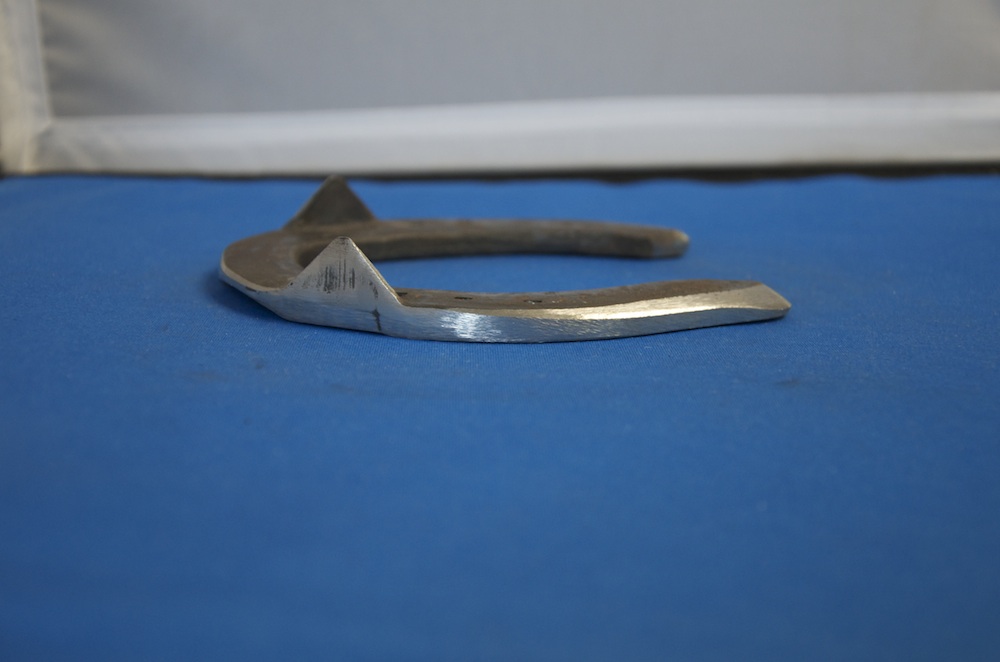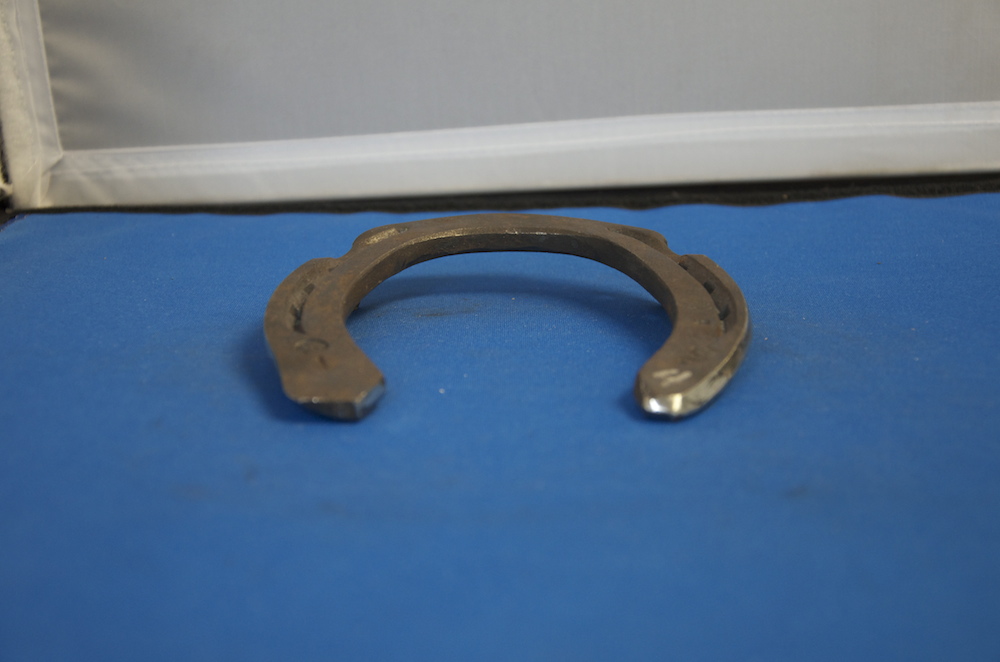When Chuck Gibson won an opportunity to spend 3 days working with Sonny Pistilli, the Belle Center, Ohio, farrier wanted to improve his forging skills in preparation for the American Farrier’s Association journeyman certification.
Gibson received that and a whole lot more.
Not only did the instruction he received from the 75-year-old Bethlehem, Pa., farrier shave about 10 minutes off the time it takes to make a pair of horseshoes, Gibson learned to make several shoes that already have benefitted his clients’ horses.
Here’s a look at some of the shoes that Pistilli and Gibson made.
(NOTE: Click on any of the following images to open the full-size version in a new window)
Front Rock Forging Horseshoe
“This is a shoe that I use for a horse that forges,” Pistilli explains. “It’s a rocker toe that I set back a little farther than normal. I like to get a little more breakover because I’m trying to get the front feet out of the way of the back feet.
“A lot of guys just bump up the front web of a shoe, but I don’t. I either go back to the front of the clip or the back of the clip. If I have a real elongated foot, I take the toe back a little more and rock the toe in back of the clip. But if I have a nice-looking foot, one that’s well balanced, I’ll rocker the shoe in front of the clip.”
Hind Forging Horseshoe
“You see the front of the toe, I take it back,” Pistilli says. “I grind that all off. You can use a hammer and box it all off, but I just grind it. I have all the tools to do that kind of stuff.
“I bevel the heel on all my hind shoes. I like my horses’ feet to have lateral support. The horse will have more of a platform to jump off of. It’s easier if you have more surface than making it real narrow. If you have your feet close together and are directly under your body, it’s easier for you to jump up. But if you widen your feet and try to jump, you don’t get as much force. It’s the same for a horse. If a horse has its feet a little closer together, it can jump better. But, if the horse is wide, it makes jumping a little harder for it to do.”
Hind Diamond-Toe Horseshoe
“I use the diamond-toe horseshoe when horses have a tendency to pull a front shoe off. Sometimes a horse hits that little bit of material that I’ve taken out of the diamond-toed shoe,” Pistilli says.
“I got the idea for this shoe from a lot of old books. The shoe was used pretty regularly on a lot of horses that had a tendency to pull off a front shoe. I’ll grind the heels on the front shoe so there’s nothing straight back. I want to be able to slide that little bit that’s missing on the hind shoe right underneath there so there’s nothing that hind shoe can grab.
“When I nail the diamond-toe shoe on, I set it back on the hind foot as much as I can and have it hanging off the back of the horse’s foot. When you have more shoe hanging off the back of the foot, it slows that foot down. It also makes the hind foot a little more upright and when that happens the stride gets shorter.”
French Deep-Seated Horseshoe
“I use the French deep-seated shoe on horses that have feet that are really broken up,” Pistilli explains. “The feet grow back even better than before with this shoe because the bevel doesn’t allow pressure on the wall. The horse is actually walking on the inside rim of the shoe. I even use that shoe if I have a horse with a little bit of sidebone.
“This shoe helps you get the nails way up, it really does. It makes it so easy to drive the nails, so you don’t have to worry about hurting them. But you have to fit the horn of the horse’s wall into the deep-seated part. In other words, you don’t just put that on a flat foot. That’s why those clips aren’t very big. That’s just so the shoe doesn’t move around on you. If you put this shoe down on the floor and measured it from the bottom of the shoe to the top of the clip, the clip is about 3/4 of an inch, but it’s really not because of the bending of the shoe. The bend is from the third nail hole all the way around.”
Hind Hunter/Jumper Horseshoe
“If you notice, the outside web of that shoe is a lot thicker than the inside,” Pistilli points out. “The reason why I use that particular type of shoe on jumpers, hunters and field hunters, is that a lot of horses, for some reason, they’re straighter on the inside and have a lot of flare on the outside.
“Most guys, when you get to shoeing a lot of horses, they tend to leave a horse a little high on the inside. You can’t see it, but when you watch a horse walk in the ring, it kind of turns its hoof. When it lands on the ground, the heels spin back.
“When I put that particular shoe on, I’ve created the inside part of the shoe to sink in the ground and the outside part of the shoe to be the opposite of what it was. It’s like a snowshoe on the outside web of the shoe. Because it sinks on the inside, the horse doesn’t spin its hocks as much.
“I grind the heel down on the foot surface so that when the horse is in mud, dirt or sand, it’s not going to put any pressure on the nails and pull it away from the foot. That’s why it’s beveled.
“It works the same way as if the rain were to run off your house, you have a slant to it. That’s why I do that to all my shoes. It’s extremely boxed on the back part of the shoe.
“The opposite heel is thinner because I wanted it to sink in the mud, and leave the opposite side out on top a little bit. From the first nail on the inside to that nail there, that’s going to change the levelness of the foot as it hits the ground, because that’s going to be on top of the ground a little more than the inside. I’ll eliminate the spinning because it’s not pivoting off something that’s higher.”
Low, High Branches; Outside, Inside Web
“I use this shoe for horses with ringbone,” Pistilli says. “It’s a classic roller shoe made by Kerckhaert.
“I had a horse that I was shoeing and he had a low ringbone. They were going to euthanize him. I tried many things to make this horse comfortable, but this was the only shoe that made him comfortable. When the shoe hits the ground, the horse is actually walking on the side of its foot rather than the front. Then when it breaks over, there’s no force in his coronary band because there’s a hollowness in the shoe, so everything is coming off the outside and inside web.
“The horse is walking on the outside and inside of the web because it’s a lot thicker out there than it is on the inside.
“When a horse gets ringbone, I roll the shoe to the third nail hole. I got that idea from using the banana shoe, except I don’t do it to the back part. I just do the very front part and get the foot to rock from the third nail forward, and it works.
Field Hunter Horseshoe
“This shoe has a wide heel on the outside,” Pistilli says. “It’s basically just my normal field hunter shoe. I bevel the inside of the shoe so it doesn’t collect mud. I want traction on all these field hunters.
“Don’t assume that you are shoeing for a good rider. Some are not as good as they think, so you kind of have to protect them. That’s my job. If I have a customer who is happy, and doesn’t get hurt, that means they’re going to be riding for a long time. I make sure that they have studs in their shoes, and if they don’t have studs, I put them in.”
You too can win an opportunity to work for 3 days with Bethlehem, Pa., farrier Sonny Pistilli. Learn more about the International Hoof-Care Summit contest by reading the article "Saving Time At The Anvil" in the September/October 2014 issue of American Farriers Journal.






















































